Mysterious findings that there is still no explanation
 Bashny.Net
Bashny.Net
Archaeologists have dug up from the ground a variety of items, most of which are quite simple arrowheads or pots. But there are those that make expert breaking heads, because to understand what it is, is very difficult. And why was this done and by whom — even more so.
1. Middle Eastern circles
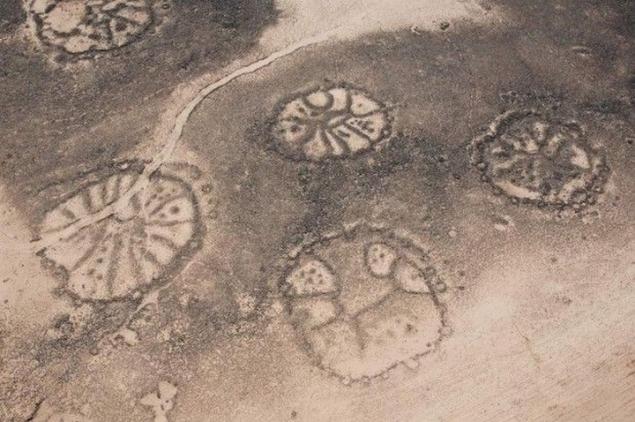
Surely you know about the Nazca lines in Peru, ancient geoglyphs visible only from height of bird's flight to fame is that they are inferior to the Egyptian pyramids. But in the middle East also have some, albeit lesser known, but even more mysterious and ancient.

These "wheels" are circular stone structures in the Syrian desert and Saudi Arabia. It is believed that they are, at least 2000 years, but nobody knew about them until the 1920-th years, i.e. until the aircraft. Archaeologists report that you need to climb at least 30 feet above the ground to see the circles.

Why they are what they are — is unclear. Some circles are grouped, others are not. In one circle there is a kind of "spokes", which correspond to astronomical phenomena, in the other "spokes" drawn as if at random. The circles may be the remains of buildings or cemeteries, but most scholars are inclined to think that they had a religious significance.
2. Wall-mount
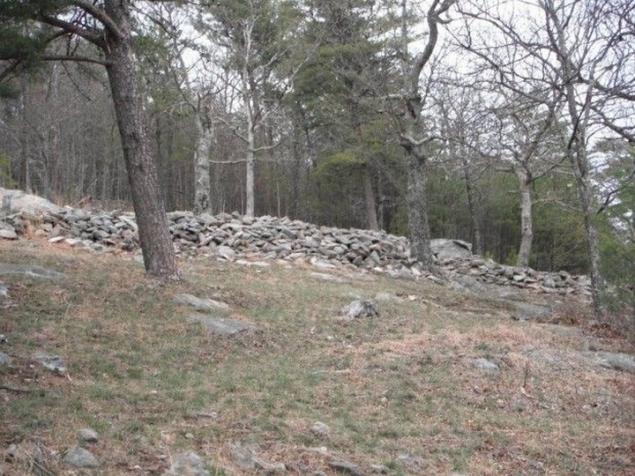
In the U.S. state of Georgia guides tourists usually say something like: "Now we come to the mysterious prehistoric wall." Yes, that's right. Who built the wall, it is not known why, too.
The wall is 270 meters in length and two meters in height, at least in some places. The entire length of the wall you can find the pits 30, and in one place there are the remains of the gate. The wall was built about 1600 years ago, though the pits may have dug much later, European treasure hunters.
There is a theory that the wall was protecting the mount from attacks, but that seems unlikely. The source of water in these places no, in some places the wall is too low, and it was built not on the slopes, which may be considered strategically important. Other theories say that the wall used to worship the Sun, or even as a border of the "resting places" for the newlyweds during honeymoon.
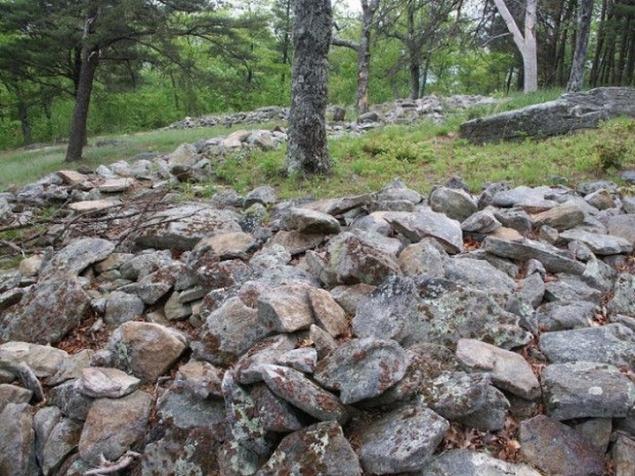
The zigzag shape of the walls similar to paintings found on native American pottery. This form can conform to the movements of the heavenly bodies, and the Northern end of the wall indicates the place of the Sun during the summer solstice.
Cherokee legend says that the builders of the walls were underground inhabitants — tall, light-skinned, bearded, waking at night and "lookie". Perhaps we are talking about the previously lived on this earth tribes hitchiti — they had beards and lived in cave-like underground structures. If they were high, and loved astronomy, the explanation seems quite logical.
3. Cross Derek Mahoney of Glastonbury
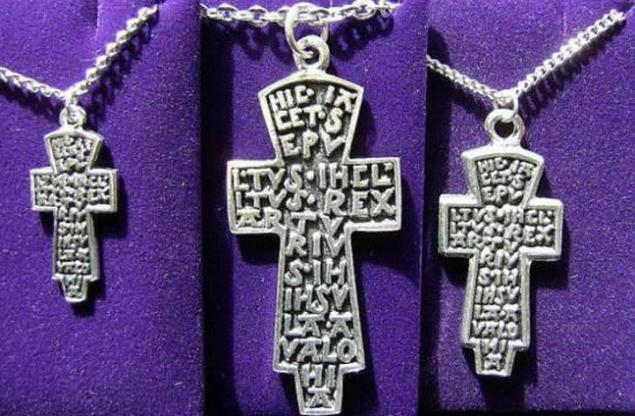
Of king Arthur there are many legends. One of them is this: in 1191, the year the monks from Glastonbury Abbey found his coffin. Next was the cross on which were engraved the words: "HIC IACET SEPULTUS INCLITUS REX ARTHURIUS IN INSULA AVALONIA", which translates as: "Here sleeps the eternal sleep of the great king Arthur on the Isle of avalon."
Many believe that the cross if there was, the monks did it themselves, to the Abbey came more pilgrims. However, the historical deception of the XII-th century very valuable. The last entry of the cross appeared in the XVII th century, and experts would like to know about the mysterious big cross. In December 1981, the year in the British Museum there was a man that said he was this cross found.
Unfortunately, Derek Mahoney refused to transfer the cross to the Museum staff or even afford to see him. Then the Museum appealed to the authorities, who owned the land where Mahoney allegedly found the artifact, and the Council got a court order on the removal of the cross. But Mahoney still refused to say where he is. In April 1982, the year the judge sentenced Mahoney to two years in prison, but said that it will be released as soon as it will finally tell you where to cross.
In January of 1983 year appointed attorney (many lawyers in England typically provide people, unable to defend himself) went to court to seek exemption Mahoney. But Mahoney, oddly enough, argued that he should remain in jail and appointed attorney is better to go somewhere else and do business. History repeated itself when the country's Highest court ordered the release of the Mahoney. Despite the fact that Mahoney objected, from the prison of his literally kicked out.
Later it turned out that Mahoney was casting mold for lead, and the necessary skills to make a fake cross. But even if he did it well enough to fool experts and to convince the authorities in the right, it still would be put in jail for such deception. But it is believed that Mahoney really knew where the cross. That's just one ancient relic did not see.
4. Tapestry of the unicorn
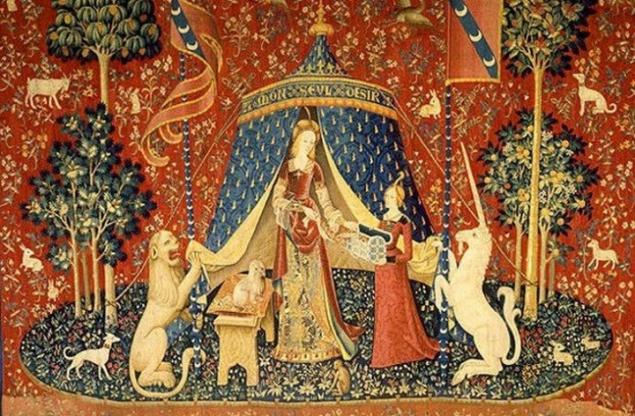
In the Cluny Museum in Paris are kept six beautiful tapestries depicting the hunt of the unicorn. Who their Creator is unknown. They were made in the XV th or XVI th century, but before 1814, the year was not a single mention of them. No one even knew about their existence until 1841, the year of the trellis, moist and polyadenine mice, not brought from home, the Chateau de Boussac.
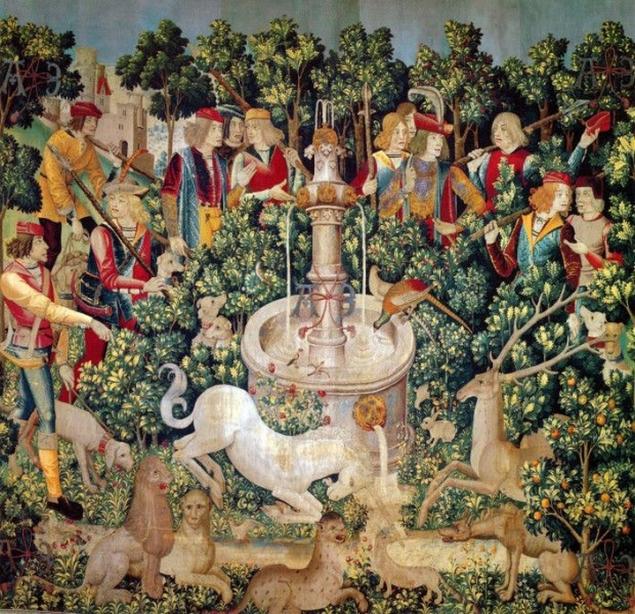
Something about the history of tapestries could say the monogram "AE" and "AF" embroidered in each corner... if anyone understand what they mean. Five of the six tapestries depicts a thin blond lady, but about who she is, too, we can only guess.
Many historians believe that it was the sister of Henry VIII Mary Tudor, who was married to king of France Louis XII in the last six months of his life. Many see the trellis allusions to marriage, love and the desire to have children.
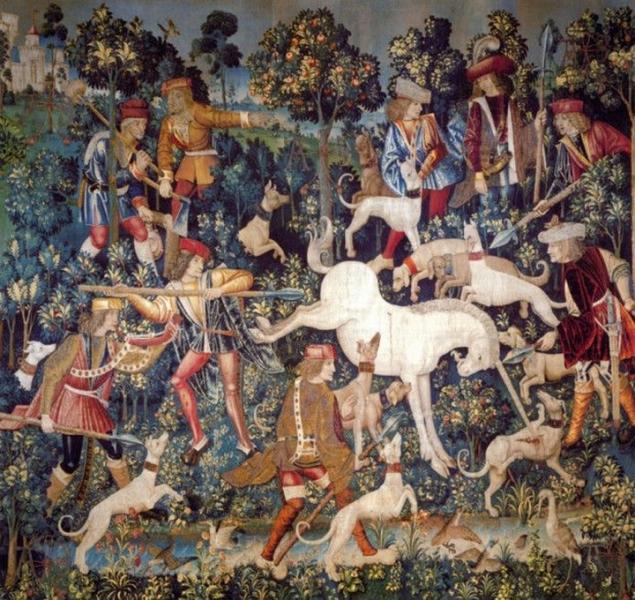
Others believe that the scenes on the tapestries indicate the five senses. On the first tapestry she touches the unicorn on the second feeding birds, on the third sniffs the flower, on the fourth playing a musical instrument, and finally, the fifth specifies the unicorn his reflection. Scientists-Christians assume that the unicorn is Christ, and the woman is his mother the virgin Mary. And there are those who believe that the scenes depict the hunt of the unicorn.
5. Skulls of Peruvians in Florida

In January 2012, the year during the excavation of the pit for the pool in South Florida was found the skull of a boy and an adult male. Small skull belonged to a ten-year child, and the bones still remained in the fabric.
Called the police — it could be a murder. But no flesh on the skull was mummified, and the two skulls was at least 800 years. Even more strange was that the skull had a unique structure, known as the Inca bone, which is characterized mainly for Peruvians.
Near the skull were other primitive artifacts — remnants of clothes and slings. Perhaps in 1930, the year I bought and brought tourists before laws banned trade in such artifacts. The same goes for skulls — perhaps they are planted to Florida migrants from Peru. In any case, to understand how the skulls of the ancient Peruvians was on someone else's back yard, is impossible.
6. Goslinski table
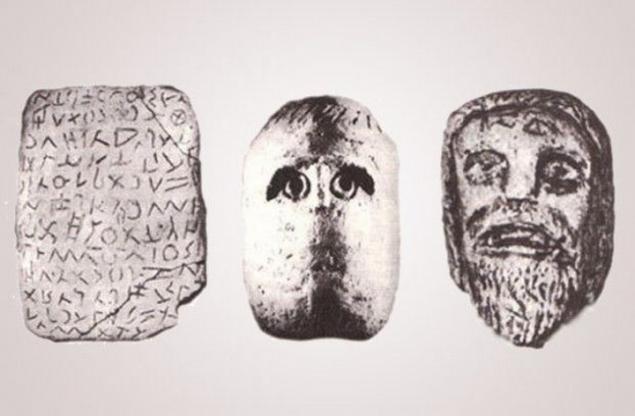
In 1924, the year of the farmer Emil Fredin found on one of their fields full of strange objects underground chamber. In it were human bones, androgynous idols, masks, and several tablets engraved with writings in a strange language. Fradin caused the archaeologists, and for many years this place has been excavated. During this time, was discovered thousands of artifacts.
About discovery conducted so many debates, "New York Times" in 1927, the year he called them "Poslinski the war" meant that all of France was divided into two camps, each of which advocated their opinions.
What's all the fuss? No one knew for sure whether the artifacts are authentic. Some archaeologists claim that the table was made in Neolithic times, and the language is a precursor to the Phoenician alphabet, from which Greek, Hebrew, Latin, Arabic and Cyrillic alphabets. If this is true, then the cradle of civilization — France and not the middle East.
Came to court: Fradin filed a lawsuit against the head of the Louvre for defamation. Then the police conducted in the farmer's house searched and found a few obviously recently cut plates. Farmer was arrested for fraud, but supporters Madina in the fraud did not believe. International experts in their reports have called all detected signs of fakes, but it only sparked controversy. Madina and not condemned.
Modern tests show that the bones in this place are collected from a variety of eras — some bones are from the 300's Godot century BC, others to the seventeenth century. The glass was made in France in the middle ages. And the signs seem to be the same age the old bones — they are certainly not less than 2000 years. The clay from which they are made, chemically identical local clay, which made them probably in France. Most experts agree that the language on the labels — one of the varieties staroseletska language. It seems no mystery there.
But it is unclear how so many unusual and varied items ended up in one place — a second place in Europe not. The only one who could know something, Fradin, so nothing was clarified — in 2010, the year he died and took the secret with him to the grave. If he knew, of course.
7. Mysterious stone
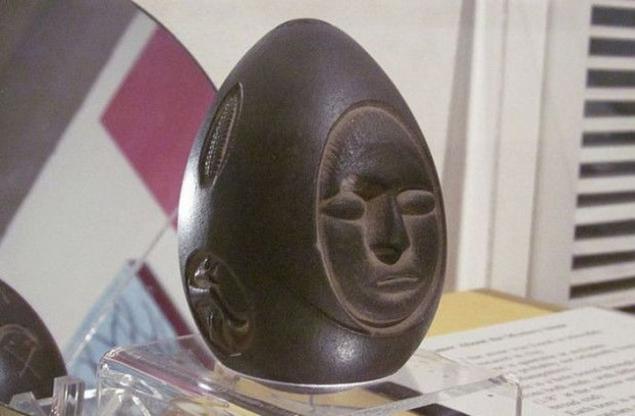
In 1872, the year during construction of the Foundation near lake Winnipesaukee in new Hampshire, USA, the builders found a strange object — it was a black stone egg carved with images of about ten centimeters tall. He immediately recognized the miracle of the scientific world: never before in the US anything similar was not and is still not found. The discovery is known as a Mysterious stone.
Front (let's call it that for lack of a better egg labeling) on the egg is engraved with the face. Sides — corn on the cob, circles, animal parts, spiral, Crescent and assorted lines and dots. At the top and bottom has numerous holes presumably created using technologies of the XIX-th century, and it means that the stone was made shortly before he was found.
Details no one recorded it. The exact location and depth, on which lay stone, is unknown. Breed of the type which consists of stone, in new Hampshire there. After almost 150 years of research, scientists still don't know who made it, and why the stone was in the ground.
8. Gold hats

Perhaps the most unusual artifacts of the bronze age in Europe can be called the four Golden hats, or cone. Their height varies from 30 cm to almost one meter. Caps are 90% made of gold and decorated with extremely complex concentric circles. The oldest known hats — Berlin cone: it was created around 1300, the year BC, and discovered in 1835, the year. Cone 1739 engraved symbols of the Sun and the moon.
Presumably the cones could be parts of the armor, ceremonial vases, jewelry, religious places or even hats "wizards", or rather, priests-astronomers. Modern analysis shows that the cones of the exact solar and lunar cycles, which first was observed by the astronomer Meton of Athens in the fifth century BC, This could mean that protochelydra culture for a few centuries ahead of its time.
9. Egyptian spiders
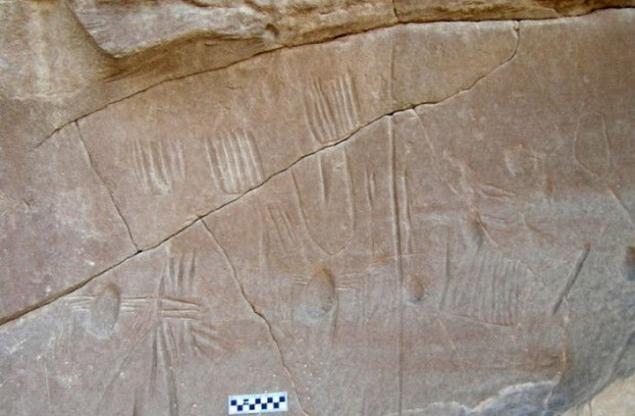
In 2013, the year archeologists have found in Egypt a large stone panel with engravings, which may be the earliest known in the world the image of spiders. Panel, probably about 6,000 years, making it older than ancient Egyptian civilization.
There are suggestions that the spiders pictured here is "blank". It seems to be true: the ovals with four thin curved "legs" look like spiders on children's drawings. Like stars images can be web.
Dr. Heather Lynn, author and proponent of "alternative archaeology", believes that are actually on panel shows are not spiders, but the star system Sirius. It is supposedly an old map of the sky — ancient people definitely liked to look up. In addition, there is ample evidence that ancient Egyptians were interested in astronomy, but about their interest in spiders is not known.
10. Aramu Muru

The Inca gate of aramu Muru in Peru is a huge "notch" in the solid rock: flat plate with two sides lined trench seven meters tall. In the center of the plate has another recess, height and width approximately. I have the feeling that someone started a carving in a rock building or something similar, and then quit.
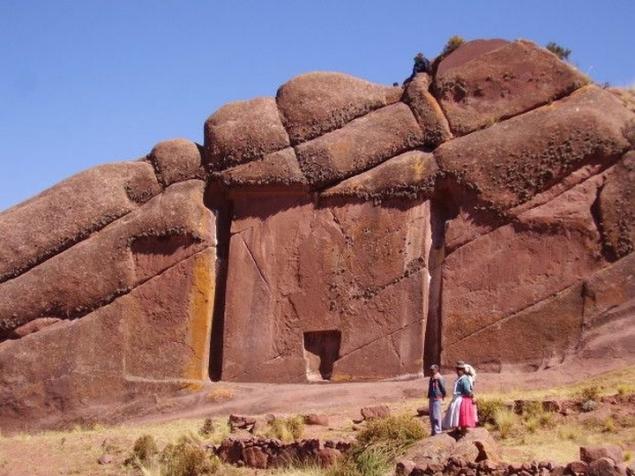
This "door" among fans of the paranormal is almost an object of worship: they consider it a magic portal. Locals consider it the gate to hell, which by using a special key or char can open mages. Some say that "the door" opens at midnight, and on the other side is the city. There is even a theory that the "gates" lead to a different end of the Universe.
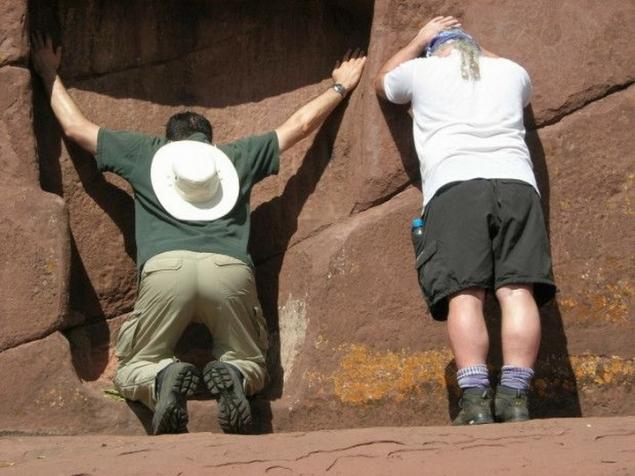
Maybe the natives thousands of years ago really opened the way to travel among the stars? It would be great if the truth was precisely this theory. But most likely, someone just had to throw construction, which is a little sad.
source
<a href="ribalych.ru/2014/05/19/tainstvennye-naxodki-kotorym-do-six-por/" style="display:none">Mysterious findings that there is still no explanation</a>
Source: /users/1080
1. Middle Eastern circles

Surely you know about the Nazca lines in Peru, ancient geoglyphs visible only from height of bird's flight to fame is that they are inferior to the Egyptian pyramids. But in the middle East also have some, albeit lesser known, but even more mysterious and ancient.

These "wheels" are circular stone structures in the Syrian desert and Saudi Arabia. It is believed that they are, at least 2000 years, but nobody knew about them until the 1920-th years, i.e. until the aircraft. Archaeologists report that you need to climb at least 30 feet above the ground to see the circles.

Why they are what they are — is unclear. Some circles are grouped, others are not. In one circle there is a kind of "spokes", which correspond to astronomical phenomena, in the other "spokes" drawn as if at random. The circles may be the remains of buildings or cemeteries, but most scholars are inclined to think that they had a religious significance.
2. Wall-mount

In the U.S. state of Georgia guides tourists usually say something like: "Now we come to the mysterious prehistoric wall." Yes, that's right. Who built the wall, it is not known why, too.
The wall is 270 meters in length and two meters in height, at least in some places. The entire length of the wall you can find the pits 30, and in one place there are the remains of the gate. The wall was built about 1600 years ago, though the pits may have dug much later, European treasure hunters.
There is a theory that the wall was protecting the mount from attacks, but that seems unlikely. The source of water in these places no, in some places the wall is too low, and it was built not on the slopes, which may be considered strategically important. Other theories say that the wall used to worship the Sun, or even as a border of the "resting places" for the newlyweds during honeymoon.

The zigzag shape of the walls similar to paintings found on native American pottery. This form can conform to the movements of the heavenly bodies, and the Northern end of the wall indicates the place of the Sun during the summer solstice.
Cherokee legend says that the builders of the walls were underground inhabitants — tall, light-skinned, bearded, waking at night and "lookie". Perhaps we are talking about the previously lived on this earth tribes hitchiti — they had beards and lived in cave-like underground structures. If they were high, and loved astronomy, the explanation seems quite logical.
3. Cross Derek Mahoney of Glastonbury

Of king Arthur there are many legends. One of them is this: in 1191, the year the monks from Glastonbury Abbey found his coffin. Next was the cross on which were engraved the words: "HIC IACET SEPULTUS INCLITUS REX ARTHURIUS IN INSULA AVALONIA", which translates as: "Here sleeps the eternal sleep of the great king Arthur on the Isle of avalon."
Many believe that the cross if there was, the monks did it themselves, to the Abbey came more pilgrims. However, the historical deception of the XII-th century very valuable. The last entry of the cross appeared in the XVII th century, and experts would like to know about the mysterious big cross. In December 1981, the year in the British Museum there was a man that said he was this cross found.
Unfortunately, Derek Mahoney refused to transfer the cross to the Museum staff or even afford to see him. Then the Museum appealed to the authorities, who owned the land where Mahoney allegedly found the artifact, and the Council got a court order on the removal of the cross. But Mahoney still refused to say where he is. In April 1982, the year the judge sentenced Mahoney to two years in prison, but said that it will be released as soon as it will finally tell you where to cross.
In January of 1983 year appointed attorney (many lawyers in England typically provide people, unable to defend himself) went to court to seek exemption Mahoney. But Mahoney, oddly enough, argued that he should remain in jail and appointed attorney is better to go somewhere else and do business. History repeated itself when the country's Highest court ordered the release of the Mahoney. Despite the fact that Mahoney objected, from the prison of his literally kicked out.
Later it turned out that Mahoney was casting mold for lead, and the necessary skills to make a fake cross. But even if he did it well enough to fool experts and to convince the authorities in the right, it still would be put in jail for such deception. But it is believed that Mahoney really knew where the cross. That's just one ancient relic did not see.
4. Tapestry of the unicorn

In the Cluny Museum in Paris are kept six beautiful tapestries depicting the hunt of the unicorn. Who their Creator is unknown. They were made in the XV th or XVI th century, but before 1814, the year was not a single mention of them. No one even knew about their existence until 1841, the year of the trellis, moist and polyadenine mice, not brought from home, the Chateau de Boussac.

Something about the history of tapestries could say the monogram "AE" and "AF" embroidered in each corner... if anyone understand what they mean. Five of the six tapestries depicts a thin blond lady, but about who she is, too, we can only guess.
Many historians believe that it was the sister of Henry VIII Mary Tudor, who was married to king of France Louis XII in the last six months of his life. Many see the trellis allusions to marriage, love and the desire to have children.

Others believe that the scenes on the tapestries indicate the five senses. On the first tapestry she touches the unicorn on the second feeding birds, on the third sniffs the flower, on the fourth playing a musical instrument, and finally, the fifth specifies the unicorn his reflection. Scientists-Christians assume that the unicorn is Christ, and the woman is his mother the virgin Mary. And there are those who believe that the scenes depict the hunt of the unicorn.
5. Skulls of Peruvians in Florida

In January 2012, the year during the excavation of the pit for the pool in South Florida was found the skull of a boy and an adult male. Small skull belonged to a ten-year child, and the bones still remained in the fabric.
Called the police — it could be a murder. But no flesh on the skull was mummified, and the two skulls was at least 800 years. Even more strange was that the skull had a unique structure, known as the Inca bone, which is characterized mainly for Peruvians.
Near the skull were other primitive artifacts — remnants of clothes and slings. Perhaps in 1930, the year I bought and brought tourists before laws banned trade in such artifacts. The same goes for skulls — perhaps they are planted to Florida migrants from Peru. In any case, to understand how the skulls of the ancient Peruvians was on someone else's back yard, is impossible.
6. Goslinski table

In 1924, the year of the farmer Emil Fredin found on one of their fields full of strange objects underground chamber. In it were human bones, androgynous idols, masks, and several tablets engraved with writings in a strange language. Fradin caused the archaeologists, and for many years this place has been excavated. During this time, was discovered thousands of artifacts.
About discovery conducted so many debates, "New York Times" in 1927, the year he called them "Poslinski the war" meant that all of France was divided into two camps, each of which advocated their opinions.
What's all the fuss? No one knew for sure whether the artifacts are authentic. Some archaeologists claim that the table was made in Neolithic times, and the language is a precursor to the Phoenician alphabet, from which Greek, Hebrew, Latin, Arabic and Cyrillic alphabets. If this is true, then the cradle of civilization — France and not the middle East.
Came to court: Fradin filed a lawsuit against the head of the Louvre for defamation. Then the police conducted in the farmer's house searched and found a few obviously recently cut plates. Farmer was arrested for fraud, but supporters Madina in the fraud did not believe. International experts in their reports have called all detected signs of fakes, but it only sparked controversy. Madina and not condemned.
Modern tests show that the bones in this place are collected from a variety of eras — some bones are from the 300's Godot century BC, others to the seventeenth century. The glass was made in France in the middle ages. And the signs seem to be the same age the old bones — they are certainly not less than 2000 years. The clay from which they are made, chemically identical local clay, which made them probably in France. Most experts agree that the language on the labels — one of the varieties staroseletska language. It seems no mystery there.
But it is unclear how so many unusual and varied items ended up in one place — a second place in Europe not. The only one who could know something, Fradin, so nothing was clarified — in 2010, the year he died and took the secret with him to the grave. If he knew, of course.
7. Mysterious stone

In 1872, the year during construction of the Foundation near lake Winnipesaukee in new Hampshire, USA, the builders found a strange object — it was a black stone egg carved with images of about ten centimeters tall. He immediately recognized the miracle of the scientific world: never before in the US anything similar was not and is still not found. The discovery is known as a Mysterious stone.
Front (let's call it that for lack of a better egg labeling) on the egg is engraved with the face. Sides — corn on the cob, circles, animal parts, spiral, Crescent and assorted lines and dots. At the top and bottom has numerous holes presumably created using technologies of the XIX-th century, and it means that the stone was made shortly before he was found.
Details no one recorded it. The exact location and depth, on which lay stone, is unknown. Breed of the type which consists of stone, in new Hampshire there. After almost 150 years of research, scientists still don't know who made it, and why the stone was in the ground.
8. Gold hats

Perhaps the most unusual artifacts of the bronze age in Europe can be called the four Golden hats, or cone. Their height varies from 30 cm to almost one meter. Caps are 90% made of gold and decorated with extremely complex concentric circles. The oldest known hats — Berlin cone: it was created around 1300, the year BC, and discovered in 1835, the year. Cone 1739 engraved symbols of the Sun and the moon.
Presumably the cones could be parts of the armor, ceremonial vases, jewelry, religious places or even hats "wizards", or rather, priests-astronomers. Modern analysis shows that the cones of the exact solar and lunar cycles, which first was observed by the astronomer Meton of Athens in the fifth century BC, This could mean that protochelydra culture for a few centuries ahead of its time.
9. Egyptian spiders

In 2013, the year archeologists have found in Egypt a large stone panel with engravings, which may be the earliest known in the world the image of spiders. Panel, probably about 6,000 years, making it older than ancient Egyptian civilization.
There are suggestions that the spiders pictured here is "blank". It seems to be true: the ovals with four thin curved "legs" look like spiders on children's drawings. Like stars images can be web.
Dr. Heather Lynn, author and proponent of "alternative archaeology", believes that are actually on panel shows are not spiders, but the star system Sirius. It is supposedly an old map of the sky — ancient people definitely liked to look up. In addition, there is ample evidence that ancient Egyptians were interested in astronomy, but about their interest in spiders is not known.
10. Aramu Muru

The Inca gate of aramu Muru in Peru is a huge "notch" in the solid rock: flat plate with two sides lined trench seven meters tall. In the center of the plate has another recess, height and width approximately. I have the feeling that someone started a carving in a rock building or something similar, and then quit.

This "door" among fans of the paranormal is almost an object of worship: they consider it a magic portal. Locals consider it the gate to hell, which by using a special key or char can open mages. Some say that "the door" opens at midnight, and on the other side is the city. There is even a theory that the "gates" lead to a different end of the Universe.

Maybe the natives thousands of years ago really opened the way to travel among the stars? It would be great if the truth was precisely this theory. But most likely, someone just had to throw construction, which is a little sad.
source
<a href="ribalych.ru/2014/05/19/tainstvennye-naxodki-kotorym-do-six-por/" style="display:none">Mysterious findings that there is still no explanation</a>
Source: /users/1080
Tags
See also
20 of the most mysterious people of the world, the origin of which is still debate
Unanswered: 10 phenomena that scientists still cannot explain
7 mysterious finds
10 mysterious technology of ancient Egypt, which still does not explain
Mystical unexplained stories (14 photos)
Difficult question? - Difficult to answer
10 Mystery of historical finds, which is still not solved
6 mysterious artifacts whose origin is still shrouded in mystery.
6 historical finds, are still not solved
World secrets, over which still puzzled scientists

















